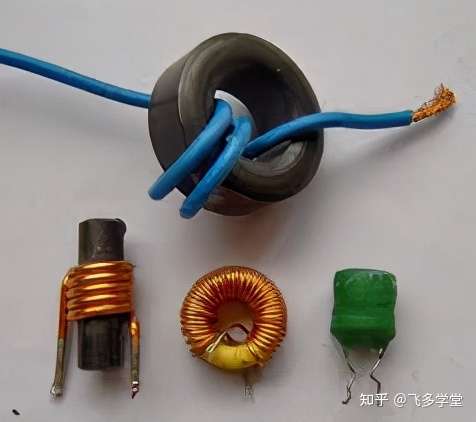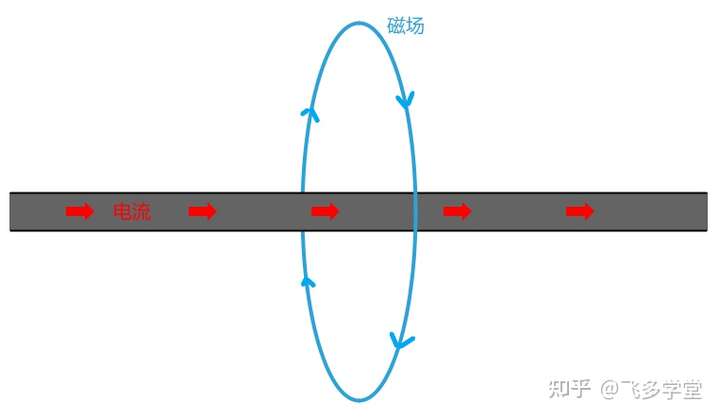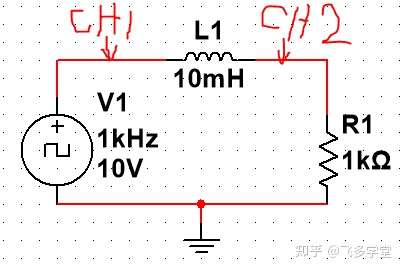Among the basic components such as resistors, capacitors and inductors, for most of us electronics enthusiasts and even hardware engineers, inductors are often the last ones to master.
Today, we use an oscilloscope to learn about inductance!
What is Inductance
Generally speaking, an inductor refers to a device that temporarily stores energy in the form of a magnetic field.
Strictly speaking, inductance should be called inductor. Inductor has the property of resisting changes in current. This property is called inductance, but this article does not distinguish between inductance and inductor.

Inductors store energy in the form of magnetic fields
Below are some pictures of the inductors:

Common Inductor Pictures
An inductor is usually just a coil of wire. One of the basic properties of electromagnetism is that when current flows through a wire, it creates a small magnetic field around the wire.

Electric current generates magnetic field
The more coils you wrap around, the stronger the magnetic field you create.
When current starts flowing through the coil, the magnetic field starts to increase... and then stabilizes... so the coil has stored some electrical energy through the magnetic field.

Inductive charging animation
When the current stops flowing, the magnetic field begins to collapse and the magnetic energy begins to be converted back into electrical energy.

Inductor discharge animation
As we all know, capacitors store electrical energy in the form of static charge and resist sudden changes in voltage. Inductors are very similar, storing energy in the form of magnetic fields and resisting sudden changes in current.
If you can only remember one thing about inductors, please remember that the current in an inductor cannot change suddenly. It always lags behind for a certain period of time.
Minimum inductance circuit
Now let's learn about inductance through a small circuit. The square wave signal source is set as follows: Duty cycle: 50%, peak-to-peak value: 10V, bias: 5V.

Small circuit
1 kHz square wave
At a signal frequency of 1 kHz, the square wave looks perfect:

Perfect square wave
Let's see how the waveform changes after adding a 10 mH inductor in series with the circuit:
 Minimum inductance circuit
Minimum inductance circuit
Square waves aren’t so perfect anymore
With the inductor, the square wave isn't quite so perfect anymore. There's some lag in the voltage change. This is because it takes some time for the inductor to store and release the energy.
10 kHz square wave
Now let's try it with a higher frequency 10 kHz square wave:

10 kHz square wave
With the 10kHz waveform, it is more obvious that the inductor is resisting the sudden change in current.
100 kHz square wave
 The square wave almost disappeared
The square wave almost disappeared
As the frequency of the input square wave increases further, the waveform flattens further. At 100 kHz, there is almost no square wave anymore. At this point, it takes longer to store and release energy in the inductor than it takes for the input square wave to switch from high to low. So, in this case, the inductor starts to gradually flatten the voltage.
DC power supply?
If you add a 1000 uF capacitor after the inductor, you will get a very smooth DC voltage.

Magic capacitor
DC power supply?
Does not work with DC
Capacitors have the function of "passing AC and blocking DC", while inductors have the opposite function of "passing DC and blocking AC". Inductors have almost no effect on DC. They are just a few turns of wire with a resistance of only a few milliohms.

Previous article:Learning about Transformers Using an Oscilloscope
Next article:Learn the basics of charge pumps using an oscilloscope
- Keysight Technologies Helps Samsung Electronics Successfully Validate FiRa® 2.0 Safe Distance Measurement Test Case
- From probes to power supplies, Tektronix is leading the way in comprehensive innovation in power electronics testing
- Seizing the Opportunities in the Chinese Application Market: NI's Challenges and Answers
- Tektronix Launches Breakthrough Power Measurement Tools to Accelerate Innovation as Global Electrification Accelerates
- Not all oscilloscopes are created equal: Why ADCs and low noise floor matter
- Enable TekHSI high-speed interface function to accelerate the remote transmission of waveform data
- How to measure the quality of soft start thyristor
- How to use a multimeter to judge whether a soft starter is good or bad
- What are the advantages and disadvantages of non-contact temperature sensors?
- Innolux's intelligent steer-by-wire solution makes cars smarter and safer
- 8051 MCU - Parity Check
- How to efficiently balance the sensitivity of tactile sensing interfaces
- What should I do if the servo motor shakes? What causes the servo motor to shake quickly?
- 【Brushless Motor】Analysis of three-phase BLDC motor and sharing of two popular development boards
- Midea Industrial Technology's subsidiaries Clou Electronics and Hekang New Energy jointly appeared at the Munich Battery Energy Storage Exhibition and Solar Energy Exhibition
- Guoxin Sichen | Application of ferroelectric memory PB85RS2MC in power battery management, with a capacity of 2M
- Analysis of common faults of frequency converter
- In a head-on competition with Qualcomm, what kind of cockpit products has Intel come up with?
- Dalian Rongke's all-vanadium liquid flow battery energy storage equipment industrialization project has entered the sprint stage before production
- Allegro MicroSystems Introduces Advanced Magnetic and Inductive Position Sensing Solutions at Electronica 2024
- Car key in the left hand, liveness detection radar in the right hand, UWB is imperative for cars!
- After a decade of rapid development, domestic CIS has entered the market
- Aegis Dagger Battery + Thor EM-i Super Hybrid, Geely New Energy has thrown out two "king bombs"
- A brief discussion on functional safety - fault, error, and failure
- In the smart car 2.0 cycle, these core industry chains are facing major opportunities!
- Rambus Launches Industry's First HBM 4 Controller IP: What Are the Technical Details Behind It?
- The United States and Japan are developing new batteries. CATL faces challenges? How should China's new energy battery industry respond?
- Murata launches high-precision 6-axis inertial sensor for automobiles
- Ford patents pre-charge alarm to help save costs and respond to emergencies
- Bicycle speedometer
- Orange pi GPIO output control, start from lighting
- People who work in software have more hair loss, will people who work in hardware be better?
- Huawei employee was sentenced for using company system bug to access confidential data without authorization; Huawei issued a letter of apology
- EEWorld Development Board Chip Coin is now open! Participate in the bidding to win a free order!
- What is the difference between SMT inductors and SMD inductors?
- Inside the DLP NIRscan Nano Evaluation Module
- How to process the current transformer signal with a single chip microcomputer
- 【2022 Digi-Key Innovation Design Competition】Material Unboxing
- DCDC isolated voltage regulated power supply module supports electric vehicle transmission and conversion, and configures high power supply system!

 开关电源设计与制作基础 (蔡宣三,倪本来编著)
开关电源设计与制作基础 (蔡宣三,倪本来编著)












 京公网安备 11010802033920号
京公网安备 11010802033920号